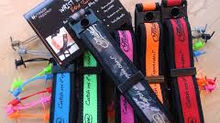How to Increase Accuracy & Precision in Archery
- Boss Crewmember Eli Rooney
- Apr 10, 2016
- 4 min read
Coming out of the hunting season and going into the 3D archery season leads us to reflect on how to improve our equipment. More often than not, hunters utilize 3D competitions to practice and hone their skills to be more successful on the hunt. Archers of any type, including target archery, are researching and hitting up all the new technology that is released every year at the ATA show held the first week of January in order to gain any kind of edge possible to out shoot the competitor or hunt the most exotic/elusive game. An extremely simple way to up your game as pertaining to performance is to upgrade the equipment that you have on your bow. Two items that any archer of any skill level can upgrade to increase performance would be the sight, and the stabilizer system.
To choose the right sight, you have to first decipher what the ultimate use of the sight will be, hunting specific, target specific, or one sight to do it all. There are multiple different variants of sights available in today’s market. These options range from fixed pin, single pin drive, or multi-pin drive sights. As a hunter, the question is then posed, how far do you plan on shooting? In that regard, I would recommend that a hunter question their ethical decision on how far is the furthest shot they would take with the current equipment they are using. Most hunters here in the west will use more fixed pin sights along with a larger number of pins simply due to the nature of spot and stalk hunting and the open country with drastic changes in elevation and terrain. A hunter back east, mostly involving tree stands, may have limited shooting lanes which means that there are a lot less opportunity for changing distances, in which a single pin sight or a fixed pin with a minimum number of pins would be more beneficial to simplify the system. There is also a huge benefit to a multi-pin housing on a drive sight. These sights give a hunter the fixed pin system they are used to as well as the ability to shoot at extended distances for both long range shots and practicing the long game to improve the short game tremendously. By clearing up the number of how many pins are in the housing, either by a single pin or low number of pins in a drive system, the field of view is increased. Also, the aiming ability is perceived to be much easier the more centered the target pin is within the scope of the sight.

Once the variant/type of the sight has been decided on , the specific add-ons must also be considered. One of the best things that an archer can do is get a sight that has multiple axis adjustments, primarily a 2nd and 3rd axis. The axes are demonstrated in the picture on the right. If the axes are incorrect, the shooter will be canting the bow to effectively “bubble up” or level the bow at the shot. Inconsistent leveling of the bow will typically render left/right variances in shot placement. Assuming that the first axis, which is set from factory on most standard bracket housing sights but needs to be set for threaded housings on most target sights, is set correctly, the 2nd axis will have the overall effect on level ground shooting. The 3rd axis would be the source for inconsistencies when shooting elevated shots (even more specifically notated as when the bow is held at any angle other than parallel to the ground with 0 degrees of incline/declination). Not all sights on the market have adjustable axis, therefore it could be beneficial to invest in a more expensive sight that does have these axis adjustments. To make these adjustments, visit your local pro shop to get you started, and for the average shooter this could be all the adjustment needed. If you are trying to get precise and extremely accurate results while setting the axes, you as the shooter should be setting these while at full draw to account for torques applied to the bow system specific to your shooting style.

The next accessory to evaluate on your bow is the stabilizer system. Stabilizers serve multiple purposes. Firstly, a stabilizer can utilize rubber dampeners or other dampening technology to remove hand-shot as well as vibrations in the bow system that result in noise reduction. Secondly and more importantly, a stabilizer system is intended to stabilize the bow to add forgiveness in the shot while balancing the bow allowing for optimum accuracy and consistency. A more advanced description would be encrypted around the idea of the Mass Moment of Inertia. What is that in layman’s terms? If you threw an object out into space, it would all rotate about a point. By adding mass further away from the center of gravity of the object (the red dot in the picture), the point of mass moment of inertia is changed and moved further away from the object (the right side of the picture). In terms of the bow, this means that the bow will hold more stable with less movement because the mass from the stabilizers pushes the axis of rotation further away. This is why in the target industry you see almost everyone with these long 3 foot (give or take) stabilizer systems.
Why don’t hunters use the same ones? Having such a large stabilizer would be impractical, making it difficult to maneuver or cumbersome to pack on long hikes. How long should a hunting stabilizer system be? If you think about when you hike with an arrow notched, that arrow will stick out a lot further than any hunting stabilizer. I myself prefer a minimum of a 8” stabilizer out the front. My personal preference for a good hunting set up that gives an infinite amount of adjustment, and that I use on my own hunting bow, is the Stokerized Stasis. Outside of the adjustable stabilizers, the only way to shop them is to try them out. Go to your local dealer to test out stabilizers with your bow and see which one gives you the most stability as well as the best overall feel in the bow!
I hope you find these tips helpful in increasing your accuracy and precision!
May your arrow fly straight and true,
Eli



















































Comments